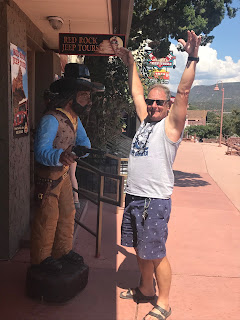Walnut Canyon was our first stop in the morning.The canyon rim elevation is 6,690 ft; the canyon's floor is 350 ft lower. A mile long with about 250 steep stairs (Steve's favorite) loop trail descends 185 ft into the canyon passing 25 cliff dwelling rooms constructed by the Sinagua people, a word in spanish meaning "without water" because the Sinagua people were able to live in such a dry region. By living in such a region the Sinagua became experts at conserving water and dealing with droughts. They were a group of pre-Columbian group that lived in Walnut Canyon from about 1100 to 1250 CE. Many of the ancient dwellings were built around a U-shaped meander in the canyon, where the creek circles around three sides of a high rocky plateau, almost creating an 'island', and this region now forms the central attraction of the national monument. The dwellings themselves were small, but large enough for the inhabitants to cook and sleep.








The next stop was Sunset Crater Volcano and Wupatki National Monuments.
These two are somewhat tied together. After the volcanic eruption causing the change in Wupatki land.
The many settlement sites scattered throughout the monument were built by the Ancient Pueblo People
, more specifically the Cohonina
, Kayenta
Anasazi
, and Sinagua
. Wupatki was first inhabited around 500 AD. Wupatki, which means "Tall House" in the Hopi language
, is a multi-story pueblo
dwelling comprising over 100 rooms and a community room and ball court, making it the largest building for nearly 50 miles. The major population influx began soon after the eruption of Sunset Crater
in the 11th century (between 1040 and 1100), which blanketed the area with volcanic ash; this improved agricultural productivity and the soil's ability to retain water. It is believed that much trading went on for goods in the community room. By 1182, approximately 85 to 100 people lived at Wupatki Pueblo but by 1225, the site was permanently abandoned, it is believed that they just moved on the better farming land.
Sunset crater
Sunset crater
In way it originally looked
Well tomorrow the Grand Canyon.




























































































